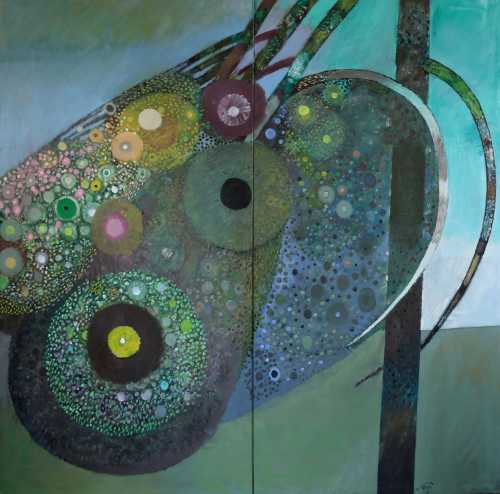About Abolghasem Saiedi
Abolghasem Saidi is one of the prominent figures of the second generation of Iranian modernists. He is known for his poetic paintings of blossoming trees; Which are more lyrical abstracts in style. Saidi learned the basics of painting from Artush Minasian. He then moved to France and studied art at the Beaux-Arts de Paris. After graduating, he settled in the western part of France and continued his professional activities.
Saidi participated in the second Tehran Biennale in 1960 and won the award of this artistic event. His works were also praised by the judges in the 5th Tehran Biennale and he won the Grand Prix of the Biennale. Abolghasem Saidi was a member of the "Group Five", which was formed by Bahman Mohasses, Sohrab Sepehri, Parviz Tanavoli and Hossein Zandehroudi and in its short period, organized two collective exhibitions in 1967 at Shiraz Art Festival and in 1968 at Goethe Institute in Tehran. Saidi’s works have been showcased many times in solo and group exhibitions inside and outside Iran.Abolghasem Saidi's first appearance in the auctions dates back to November 2007 at the Christie's Auction House.
Saeedi's career can be divided into several distinct periods in terms of style. In the first period of his career, he painted in the Impressionist style, but after immigrating to France, under the influence of the "human-witness" group, he changed his style and adopted a realistic style. The "human-witness" members were young French painters who, in defiance of existentialist tendencies, defended social realism and rejected the prevailing abstract tendencies. The painting "Young Widow" is one of the outstanding works of this period, which in 1959 won him the Young Painting Salon Award. The cold and dark colors of this period in his paintings depict a bitter and sad atmosphere.
After this period, humans gradually leave Saidi’s frame and give way to nature and trees. The sadness and gloom of the early period of his work are replaced by bright and cheerful colors. The whip, fluid, and rhythmic lines he uses to draw the branches of trees are indirectly inspired by the calligraphies in his contemporaries. Saidi has an ornamental behavior in depicting the blossoms of trees and uses a circular motif of cheerful and bright colors. On the one hand, this quality is rooted in the decorative properties of Iranian paintings, and on the other hand, it is associated with the modernist features of "Art Nouveau". Ruyin Pakbaz writes about this: "Fruitful spring trees with branches bent to the sky or bent to the ground, in their rhythmic twist, announce the greatness of life force. Light is everywhere and dissolves volumes and distances. "Shapes take on calligraphic order and colors shine like jewels."
In the next period of his works, Saiedi distances himself from this happy and lively atmosphere. In Pakbaz's words the trees in his later works are: "not a manifestation of the passion of prosperity but of a mysterious moment of silence." "His work grows in silence, in contemplation, and in the sobriety of colors with an incredibly beautiful harmony," writes Guy Vinio, an art critic, on the occasion of showcasing Saidi’ works in Taylor Foundation. "That is how the sense of a conscious artist depicts the freshness of his beautiful talents in enduring forms, in a pure way like the rising of a sun."
Saidi participated in the second Tehran Biennale in 1960 and won the award of this artistic event. His works were also praised by the judges in the 5th Tehran Biennale and he won the Grand Prix of the Biennale. Abolghasem Saidi was a member of the "Group Five", which was formed by Bahman Mohasses, Sohrab Sepehri, Parviz Tanavoli and Hossein Zandehroudi and in its short period, organized two collective exhibitions in 1967 at Shiraz Art Festival and in 1968 at Goethe Institute in Tehran. Saidi’s works have been showcased many times in solo and group exhibitions inside and outside Iran.Abolghasem Saidi's first appearance in the auctions dates back to November 2007 at the Christie's Auction House.
Saeedi's career can be divided into several distinct periods in terms of style. In the first period of his career, he painted in the Impressionist style, but after immigrating to France, under the influence of the "human-witness" group, he changed his style and adopted a realistic style. The "human-witness" members were young French painters who, in defiance of existentialist tendencies, defended social realism and rejected the prevailing abstract tendencies. The painting "Young Widow" is one of the outstanding works of this period, which in 1959 won him the Young Painting Salon Award. The cold and dark colors of this period in his paintings depict a bitter and sad atmosphere.
After this period, humans gradually leave Saidi’s frame and give way to nature and trees. The sadness and gloom of the early period of his work are replaced by bright and cheerful colors. The whip, fluid, and rhythmic lines he uses to draw the branches of trees are indirectly inspired by the calligraphies in his contemporaries. Saidi has an ornamental behavior in depicting the blossoms of trees and uses a circular motif of cheerful and bright colors. On the one hand, this quality is rooted in the decorative properties of Iranian paintings, and on the other hand, it is associated with the modernist features of "Art Nouveau". Ruyin Pakbaz writes about this: "Fruitful spring trees with branches bent to the sky or bent to the ground, in their rhythmic twist, announce the greatness of life force. Light is everywhere and dissolves volumes and distances. "Shapes take on calligraphic order and colors shine like jewels."
In the next period of his works, Saiedi distances himself from this happy and lively atmosphere. In Pakbaz's words the trees in his later works are: "not a manifestation of the passion of prosperity but of a mysterious moment of silence." "His work grows in silence, in contemplation, and in the sobriety of colors with an incredibly beautiful harmony," writes Guy Vinio, an art critic, on the occasion of showcasing Saidi’ works in Taylor Foundation. "That is how the sense of a conscious artist depicts the freshness of his beautiful talents in enduring forms, in a pure way like the rising of a sun."
The Most Expensive Artwork
At Auctions
First Attendance
31 October 2007
# Attendance
44
# Artworks
52
Average Realized Price
53,385 USD
Average Min Estimate
34,125 USD
Average Max Estimate
45,507 USD
Sell-through Rate
63.462%
Average Growth of Artwork Worth
61.474%
Timeline
Landscape Plateau exhibition
13 December
Post-war & Contemporary Art auction
6 December
Timeless Creation exhibition
25 October
American, European and Ukrainian Fine Art auction
16 August
Decades Projects 1300-1310 exhibition
2 August
The 20th Tehran- Modern and Contemporary Iranian Art auction
5 July
A Collection exhibition
10 May
The 17th Tehran Modern and Contemporary Iranian Art auction
18 July
Intersect 01 exhibition
19 May
Group Exhibition Nasut and Nature 2 exhibition
13 May
The 15th Tehran- Modern Iranian Art auction
14 January
The Mana Jalalian Collection: A Rare Collection of Iranian Modern Art exhibition
15 November
The 13th Tehran- Modern and Contemporary Iranian Art auction
15 January
Modern and Contemporary Middle Eastern Art auction
24 November
One by One exhibition
3 July
20th Century Art / Middle East auction
22 October
یازدهمین دوره حراج تهران auction
5 July
Municipal Credit Sales Room auction
12 June
Modern and Contemporary Paintings and Sculptures auction
4 May
Modern and Contemporary Middle Eastern Art auction
1 May
Abstract and Contemporary Art auction
12 December
The 9th Tehran- Classic and Modern Iranian Art auction
29 June
Egypt's Awakening and Modern and Contemporary Middle Eastern Art auction
18 April
Modern & Contemporary Paintings, Sculptures auction
13 December
MODERN AND CONTEMPORARY ART FROM THE MIDDLE EAST auction
6 December
Modern and Contemporary Middle Eastern Art auction
28 November
Boundless: Dubai auction
13 November
هفتمین دوره حراج تهران auction
7 July
Drouot Richelieu, Salle 5, Art Abstrait et Contemporain auction
9 June
Modern & Contemporary Art auction
18 March
Contemporary and Abstract Paintings, Modern Paintings auction
31 October
Art, Furniture, Jewelry, Asian auction
16 October
ABSTRACT & CONTEMPORARY ART auction
15 June
پنجمین دوره حراج تهران auction
27 May
The Art of Lebanon and Modern and Contemporary Middle Eastern Art auction
27 April
Modern & Contemporary Art auction
16 March
European Art & Old Masters auction
25 January
Annual Amordad 94 exhibition
14 August
The first solo exhibition of Abolghasem Saeedi in Iran exhibition
12 June
20th Century & Contemporary Art auction
3 June
چهارمین دوره حراج تهران auction
29 May
سومین دوره حراج تهران auction
30 May
Fine Art Auction for October auction
5 October
Contemporary Art / Arab & Iranian auction
4 October
Modern & Contemporary Middle Eastern Art & South Asian Art auction
1 June
Drouot Richelieu, Salle 7, Vente Tableaux Modernes auction
19 November
Contemporary Art / Arab & Iranian auction
20 October
Modern & Contemporary Middle Eastern & South Asian Art auction
12 October
International Modern & Contemporary Art auction
29 April
ORIENTALISM AND ISLAMIC ART auction
15 December
Modern & Contemporary Arab, Iranian, Indian & Pakistani Art auction
24 November
International Modern and Contemporary Art auction
31 October
Articles
۱7th Tehran Auction Sales Report 26 July 2023
The 17th Tehran auction: modern and contemporary, was held on Friday July 21st, 2023 at Parsian Azadi Hotel. This auction achieved a total sale of 214 billion tomans equivalent to 4.3 million dollars, which was a growth of 77.8% compared to the previous period. Artchart has observed the 17th Tehran auction in the upcoming report.

